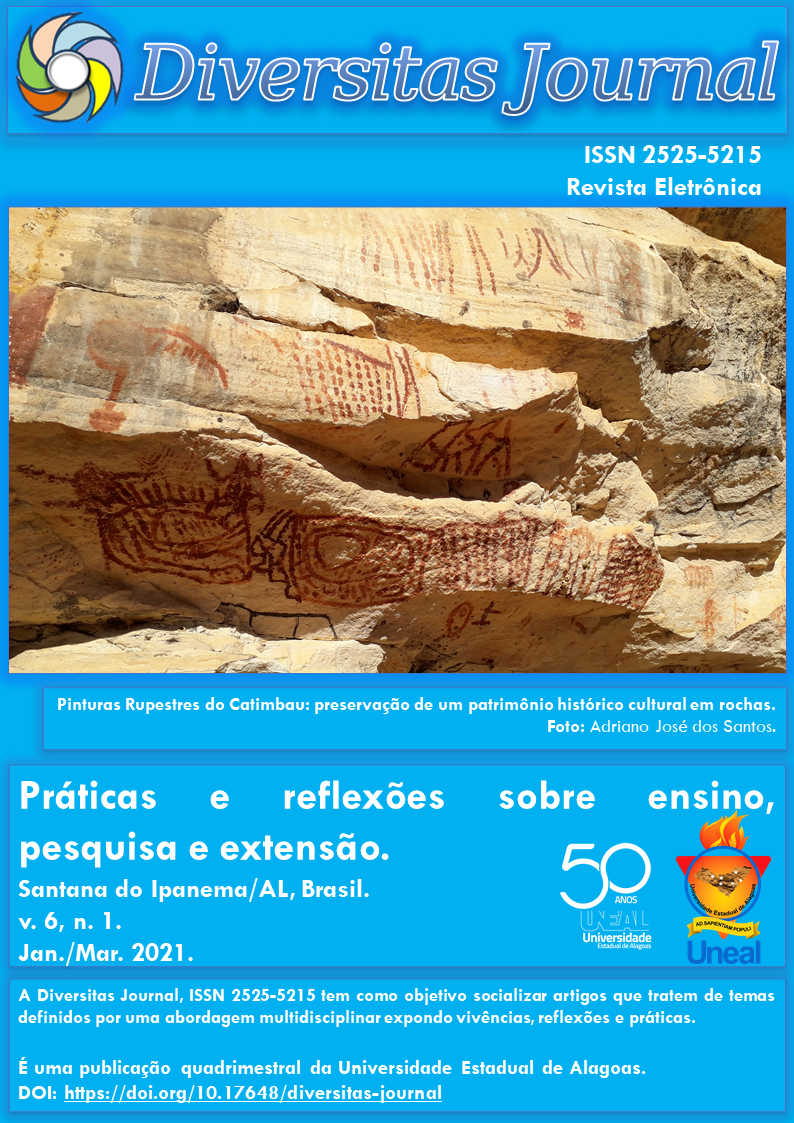Uso de planejamento fatorial no estudo do potencial fitotóxico de Amburana cearensis (Fabaceae), Delonix regia (Fabaceae), Tabebuia avellanedae (Bignoniaceae) sobre sementes de alface
DOI:
https://doi.org/10.17648/diversitas-journal-v6i1-1580Abstract
ABSTRACT: Weeds are one of the main problems in the cultivation of agricultural products and the main method of control is still the use of chemical herbicides, which are efficient, have direct and indirect consequences that outweigh the benefits in many cases, thus opening the way for research and development of bioherbicides. Therefore, the objective of this study was to evaluate, through a factorial design 23, which is the best experimental pathway to inhibit the germination of Lactuca sativa seeds, studying the variables concentration, part of the plant and extraction solvent in addition to your interactions. Thus, ethanol extracts were chosen, as well as aqueous extracts from the stem bark and leaves of three species occurring in the state of Alagoas. Following the germination bioassays and initial growth of L. sativa seeds compared to extracts in the 50% and 100% operations in the laboratory. It was evidenced that the ethanolic extract of Delonix regia in a more diluted concentration is more efficient in inhibiting germination. In relation to the species Amburana cearensis and Tabebuia avellanedae, better inhibition effects were required when the extracts were from the stem and leaf respectively.
KEYWORDS: Allelochemicals, Pest Control, Statistical Analysis.
Metrics
References
AKHTAR,S., et al. Avaliação alelopática de pacientes selecionados espécies invasoras do Paquistão. Pakistan Journal of Botany. v. 46, n. 5, p. 1709-1713, 2014.
ALLEM, L. N. Atividade alelopática de extratos e triturados de folhas de Caryocar brasiliense Camb. (Caryocaraceae) sobre o crescimento inicial de espécies alvo e identificação de frações ativas através de fracionamento em coluna cromatográfica. 2010. 84 folhas. Dissertação (Mestrado) Instituto de Ciências Biológicas, Departamento de Botânica, Universidade de Brasília, Brasília-DF, 2010.
ALMEIDA, J. R. G. S., et al. Amburana cearensis-uma revisão química e farmacológica. Scientia Plena, Aracaju, v. 6, n. 11, nov. 2010.
ANDREO, D.; JORGE, N. Antioxidantes naturais: técnicas de extração. Boletim Centro de Pesquisa de Processamento de Alimentos, v. 24, n. 2, p. 319-336, 2006.
ARARUNA, S. M.; LEAL, L. K. A. M. Desenvolvimento do extrato seco padronizado por spray dring de Amburana cearensis A. C. Smith. (Cumaru): otimização, produção, caracterização e avaliação farmacológica. 2013, 100 folhas. Tese (Doutorado)Programa de Pós-graduação em Desenvolvimento e Inovações Tecnológicas em Medicamentos, Universidade Federal do Ceará, Fortaleza-CE, 2013.
BLAIR, A. C., et al. The importance of analytical techniques in allelopathy studies with the reported allelochemical catechin as an example.Biological invasions, v. 11, n. 2, p. 325-332, 2009.
BORGES, E. E. L.; SILVA, G. F.; LOPES, E. S. Avaliação de substâncias Alelopáticas em vegetação de uma floresta secundária. 2 –Arbustos. Revista Árvore, v. 18, n. 3, p. 275-286, 1994.
BORGHETTI, F.; FERREIRA, A. G. Interpretação de resultados de germinação. In: FERREIRA, A. G.; BORGHETTI, F. (Org.). Germinação: do básico ao aplicado. 2. ed. Porto Alegre: Artmed, p. 324. 2004.
BOX,G.E.P., et al.Statistics for experimenters. New York: John Wiley and sons, 1978.
BRIGHENTI, A. M.; et al.. Controle de Plantas Daninhas por Roçada Articulada e Eletrocussão. Controle de Plantas Daninhas, p. 34, 2018.
BRITO, I. C. A., et al. Alelopatia de espécies arbóreas da caatinga na germinação e vigor de sementes de feijão macaçar e de milho. Revista Verde, v.7, n.1, p. 129 -140 2010.
BUDNI, P., et al. Estudos preliminares da atividade antioxidante do extrato hidroetanólico de folhas jovens e adultas de Tabebuia heptaphylla (Vell.) Toledo (ipê-roxo). Latin American Journal of Pharmacy, v. 26, n. 3, p. 394, 2007.
CANUTO, K. M.; SILVEIRA, E. R.; SMITH, A. C. Constituintes químicos da casca do caule de Amburana cearensis. Química Nova, v. 29, n. 6, p. 1241, 2006.
CAPOBIANGO, R. A.; VESTENA, S.; BITTENCOURT, A. H. C. Alelopatia de Joanesia princeps Vell. e Caseariasylvestris Sw. sobre espécies cultivadas. Revista Brasileira de armacognosia, v.19, n. 4, p. 924-930. 2009.
CASTELLANOS, J. R. G.; PRIETO, J. M.; HEINRICH, M. Red Lapacho (Tabebuia impetiginosa) -a global ethnopharmacological commodity? Journal of Ethnopharmacology, v. 121, n. 1, p. 1-13, 2009.
CHRISTOFFOLETI, P. J.; OVEJERO, R. F. L.; CARVALHO, J. C. Aspectos de resistência de plantas daninhas a herbicidas. Campinas. Associação Brasileira de Ação à Resistência de Plantas aos Herbicidas, 2004.
CORSATO, J. M., et al. Efeito alelopático do extrato aquoso de folhas de girassol sobre a germinação de soja e picão-preto. Semina: Ciências Agrárias, v. 31, n. 2, p. 353-360, 2010.
DAYAN, F. E.; CANTRELL, C. L.; DUKE, S. O. Natural products in crop protection. Bioorganic & Medicinal Chemistry, v. 17, n. 12, p. 4022-4034, 2009.
DAYAN, F. E. and DUKE, S. O. Natural compounds as next generation herbicides. Plant Physiology, v. 166, n. 3, p. 1090-1105, 2014.
DEL REY, J. C., et al. Field sprayer for inter and intra-row weed control: performance and labor savings.Spanish Journal of Agricultural Research, n. 3, p. 642-651, 2013.
DEUBER, R. Métodos de manejo das plantas infestantes. In: DEUBER, R. Ciência das plantas infestantes: fundamentos. Jaboticabal: FUNEP, p. 106-148, 2006.
EDWARDS, C. A. (Ed.).Environmental pollution by pesticides. Springer Science & Business Media, 2013.
FAROOQ, M., et al. The role of allelopathy in agricultural pest management.Pest Management Science,v. 67, n. 5, p. 493-506, 2011.
FATORETO, J. A. S., et al. Análise do efeito dos produtos homeopáticos sobre a germinação de Delonix regia. Revista Uningá, v. 10, n. 1, 2006. Out./dez., 2006.
FERREIRA, A. G., AQUILA, M. E. A. Alelopatia: uma área emergente da ecofisiologia. Revista Brasileira de Fisiologia Vegetal, v. 12, n. 1, p. 175-204, 2000.
GATTI, A. B.; PEREZ, S. C. J. G. A.; LIMA, M. I. S. Atividade alelopática de extratos aquosos de Aristolochia esperanzae O. Kuntze na germinação e no crescimento de Lactuca sativa L. e Raphanus sativus L.Acta Botanica Brasilica, v. 18, n. 3, p. 459-472, 2004.
GELMINI, G. A., et al. Resistência de biótipos de Euphorbia heterophylla L. aos herbicidasinibidores da enzima ALS utilizados na cultura de soja.Bragantia, v. 60, n. 2, p. 93-99, 2001.
GIANESSI, L. P. The increasing importance of herbicides in worldwide crop production.Pest Management Science, v. 69, n. 10, p. 1099-1105, 2013.
GOBBO-NETO. L., LOPES, N. P. Plantas medicinais: fatores de influência no conteúdo de metabólitos secundários. Química Nova, v. 30, n. 2, p. 374-381, 2007.
GOLDFARB, M., PIMENTEL, L. W., PIMENTEL, N. W. Alelopatia: relações nos agros ecossistemas. Revista Tecnologia & Ciência Agropecuária, v. 3, n. 1, p. 23-28, 2009.
GUSMAN, G. S. et al. Allelopathy of plant species of pharmaceutical importance to cultivated species.Biotemas, v. 25, n. 4, p. 37-48, 2012.
HAMINIUK, C. W. I., et al. Extraction and quantification of phenolic acids and flavonols from Eugenia pyriformis using different solvents. Journal of Food Science and Technology, v. 51, n. 10, p. 2862-2866, 2014.
HEAP, I. 2018. The International Survey of Herbicide Resistant Weeds. Online. Disponível em: http://www.weedscience.org. Acessado em: 14 de julho de 2020.
HONG, N. H.; XUAN, T. D.; EIJI, T. & KHANH, T. D. Controle de plantas daninhas em casca por plantas superiores do sudeste da Ásia. Crop Protection. v. 23, n. 3, p. 255-261, 2004.
LÓPEZ, R. E. S. Delonix regia (Bojer ex Hook.) Raffin (Fabaceae). Revista Fitos Eletrônica, v. 5, n. 02, p. 45-51, 2013.
LORENZI, H.; MATOS, F. J.Plantas medicinais no Brasil: nativas e exóticas. 2002.
MACHADO, T. B., et al. In vitro activity of Brazilian medicinal plants, naturally occurring naphthoquinones and their analogues, against methicilin-resistant Staphylococcus aureos. International Journal of Antimicrobial Agents,v. 21, n. 3, p. 279-284, 2003.
MAIA-SILVA, C., et al. Guia de plantas visitadas por abelhas na Caatinga. Fortaleza: Fundação Brasil Cidadão, p. 192-194, 2012.
MARASCHIN-SILVA, F.; AQUILA, M. E. A. Potencial alelopático de espécies nativas na germinação e crescimento inicial de Lactuca sativaL. (Asteraceae). Acta Botanica Brasilica,v. 20, n. 1, p. 61-69, 2006.
MARTINS, C. R.; LOPES, W. A.; ANDRADE, J. B. D. Solubilidade das substâncias orgânicas. Química nova, v. 36, n. 8, p. 1248 –1255, 2013.
MECINA, G. F. Investigação das atividades alelopática, fitotóxica e antioxidante de extratos efrações de Tridax procumbens L. (Asteraceae). e Ouratea spectabilis (mart. ex engl.) engl. (Ochnaceae). 2014. 81 folhas. Dissertação (Mestrado) Faculdade de Ciências e Letras de Assis –Universidade Estadual Paulista, Assis-SP, 2014.
MELO, C. A.; SOUZA, P. O.; DAMASCENO, E. Atividade farmacológica da planta Amburana cearensis (Imburana). Frente a estudos etnofarmacológico em Monte Azul-MG. Revista Brasileira de Pesquisa em Ciências da Saúde, p. 31-34, 2014.
MENDONÇA, R. L. Determinação de aleloquímicos por HPLC/UV-Vis em extratos aquosos de sementes de Canavalia ensiformis e estudo da atividade alelopática.2008. Tese de Doutorado. Universidade de São Paulo. São Paulo, 2008.
MIRANDA, F. G. G., et al. Antinociceptive and antiedematogenic properties and acute toxicity of Tabebuia avellanedae Lor. ex Griseb. inner bark aqueous extract. BMC Pharmacology, v. 1, n. 1, p. 6, 2001.
OLIVEIRA, M. N. S., et al. Efeitos alelopáticos de extratos aquoso e etanólico de jatobá do cerrado. Unimontes Científica, v. 4, n. 2,p. 143-152, 2008.
PARENTE, K., PARENTE FILHO, E. G., & SILVA, É. V. Alelopatia de Ziziphus joazeiro Mart. sobre Lactuca sativaL. e Lycopersicon esculentum Mill. Revista Fitos, Rio de Janeiro, Vol. 9(2): 73-159, 2015.
PERALTA-ZAMORA, P.; MORAIS, J. L.; NAGATA, N. Por que otimização multivariada? Engenharia Sanitária e Ambiental.v. 10, n. 2, p. 106-110, 2005.
PEREIRA, K. C. L., et al. Potencial alelopático do extrato etanólico de Anacardium humile A. St. Hil. (cajuzinho-do-cerrado) na germinação e formaçãode plântulas de Lactuca sativaL.(alface), Lycopersicon esculentumMill.(tomate) e Senna obtusifolia(L.) Irwin & Barneby (fedegoso). Gaia Scientia, v. 12, n. 2, p. 144-160, 2018.
PERVEEN, S., et al. Bioherbicidal potential of some allelopathic agroforestry and fruit plant species against Lepidium sativum.Soil & Environment, v. 38, n. 1, p. 11-18, 2019.
PIMENTEL, J. V. F.; GUERRA, H. O. C. Crescimento inicial de Amburana cearensis (Allem) A. C. Smith em sistema agroflorestal no semiárido brasileiro. Revista Ciência Florestal,v. 25, n. 3, p. 771-780, 2015.
PIRES, N. M., et al. Atividade alelopática da leucena sobre espécies de plantas daninhas.Scientia Agricola,v. 58, n. 1, p. 61-65, 2001.
PRATES, H. T.; PAES, J. M. V.; PIRES, M. N.; PEREIRA-FILHO, I. A.; MAGALHÃES, P. C. Efeito do extrato aquoso de leucena na germinação e no desenvolvimento do milho. Pesquisa Agropecuária Brasileira, v. 35, p. 62-68. 2000.
PRESTON, C. "Herbicide detoxification: herbicide selectivity in crops and herbicide resistance in weeds." p. 195-204. 2005.
REZENDE, C. P.; PINTO, J. C.; EVANGELISTA, A. R.; SANTOS, I. P. A. Alelopatia e suas interações na formação e manejo de pastagens plantas forrageiras. Boletim Agropecuário (Lavras:UFLA) 2003. 18p.
RODRIGUES, M. I., IEMMA, A. F., Planejamento de Experimentos e Otimização de Processos, 2. ed. Campinas: Casa do Pão Editora, 2009.
ARMADA, N.R.; AMOROSO, M. J. D. R.; RAJAL, V. B. Effect of glyphosate application on soil quality and health under natural and zero tillage field conditions. Soil and Environment,36(2):141-154,2017.
SANTOS, L. O., et al. Avaliação da Atividade Antioxidante dos Compostos Fenólicos Presentes na Amburana cearensis. Orbital: The Electronic Journal of Chemistry, v. 1, n. 1, p. 44-49, 2016.
SHABIR, G., et al. Antioxidante and antimicrobial atributes and phenolic of diferente solvente extracts fron leaves, flowers and bark of Gold Mohar [Delonix regia (Bojer ex. Hook.) Raf.]. Molecules, v. 16, p. 7302-7319, 2011.
SILVA, A. A.; SILVA, J. F. Tópicos em manejo de plantas daninhas. Viçosa, MG: Universidade Federal de Viçosa, v. 1, p. 55-56, 2007.
SILVA, A. S.Avaliação da secagem do bagaço de cajá usando planejamento fatorial composto central.2008. Dissertação (Mestrado). Universidade Federal do Rio Grande do Norte. Natal-RN, 2008.
SILVA, P. S. S. Atuação dos aleloquímicos no organismo vegetal e formas de utilização da alelopatia na agronomia.Biotemas,v. 25, n. 3, p. 65-74, 2012.
SILVEIRA, P.F, et al. Potencial alelopático do extrato aquoso de cascas de jurema pretano desenvolvimento inicial de alface. Revista Caatinga, v. 25, n. 1, p. 20-27, 2012.
SOLTYS, D., et al. Allelochemicals as bioherbicides present and perspectives. In:Herbicides-Current research and case studies in use. IntechOpen, 2013.
VALCÁRCEL, M. A modern definition of analytical chemistry. Trends in Analytical Chemistry, v. 16, n. 3, p. 124-131, 1997.
VYVYAN, J. R., et al. Total synthesis of (±)-heliannuol C and E via aromatic Claisen rearrangement.Tetrahedron letters, v. 46, n. 14, p. 2457-2460, 2005.
WANDSCHEER, A. C. D.; PASTORINI, L. H. Interferência alelopática de Raphanus raphanistrum L. sobre a germinação de Lactuca sativaL. e Solanum lycopersiconL. Ciência Rural, v. 38, n. 4, p. 949-953, 2008.
YOUNG, B. J., et al. Toxicity of the effluent from an anaerobic bioreactor treating cereal residues on Lactuca sativa. Ecotoxicology and Environmental Safety, n.76, p.182-186, 2012.
ZHAO-HUI LI, QIANG, W., XIAO, R., CUN-DE PAN and DE-AN JIANG. Phenolics and Plant Allelopathy. Molecules, v. 15, p. 8933-8952. 2010.
Downloads
Published
How to Cite
Issue
Section
License
Copyright (c) 2021 Erika Matias da Silva, Érik José Ferreira da Silva, Edjane Vieira Pires, Cenira Monteiro de Carvalho, Wagner Roberto de Oliveira Pimentel, Pedro Almeida do Nascimento Júnior

This work is licensed under a Creative Commons Attribution 4.0 International License.
The Diversitas Journal expresses that the articles are the sole responsibility of the Authors, who are familiar with Brazilian and international legislation.
Articles are peer-reviewed and care should be taken to warn of the possible incidence of plagiarism. However, plagiarism is an indisputable action by the authors.
The violation of copyright is a crime, provided for in article 184 of the Brazilian Penal Code: “Art. 184 Violating copyright and related rights: Penalty - detention, from 3 (three) months to 1 (one) year, or fine. § 1 If the violation consists of total or partial reproduction, for the purpose of direct or indirect profit, by any means or process, of intellectual work, interpretation, performance or phonogram, without the express authorization of the author, the performer, the producer , as the case may be, or whoever represents them: Penalty - imprisonment, from 2 (two) to 4 (four) years, and a fine. ”


















